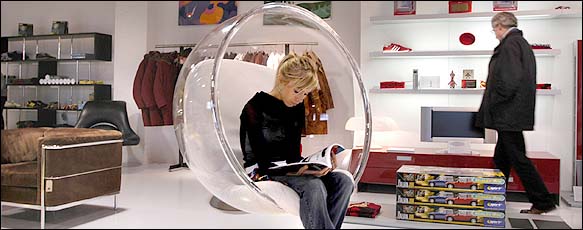
If fashion seemed plagued last year with the chronic drears, the economy was only partly to blame. One of the most poorly kept secrets among analysts of the clothing business and, indeed, of retailing in general is that consumers have begun defecting from the culture of shopping, surfeited with information and alienated by what increasingly seems like the mere illusion of choice.
"You've got an economy that is 90 percent driven by consumers and reliant on convincing people to keep buying stuff," said Barry Schwartz, a professor of psychology at Swarthmore College and the author of "The Paradox of Choice: Why More Is Less" (soon to be published by HarperCollins). "You also have a culture in which people are saturated, looking for ways to simplify their lives and to reduce time spent trying to figure out what to buy."
Mr. Schwartz illustrated his point with a story about shopping for jeans. Once a straightforward transaction in the days of fewer brands and styles, buying blue jeans now involves threading a maze of brands, colors, styles and fit. "The presumption we've been operating under is that, if some choice is good, more is better," he said.
The flaw in that thinking became clear at the local mall, where, Mr. Schwartz said, he found "a hundred different varieties of jeans and a sudden need to know which ones were the best, and fit best, despite my former complete indifference to that."
Mr. Schwartz explained that all manner of problems arise when consumers are provided with too much choice, an observation that far-seeing retailers intuitively know. Before Colette in Paris became a consumer mecca, it was considered something new: a concept store. The concept in question was never all that complicated. For Colette, Sarah Lerfel and her talented buyers selected goods from the fashion marketplace as if the shop on the Rue St.-Honoré were a monthly evolving independent magazine. Robert Burke, the fashion director of Bergdorf Goodman, said: "It all goes back to being a merchant, really understanding how to merchandise and not just buy brands." In the days before label dressing became viral and designers took to calling the shots, department store buyers functioned as editorial filters for consumers. "If you can speak to a group of people through your taste, you have a business," Mr. Burke said. "I think that's coming back."
Consumers want to see a point of view when they are shopping, said Christopher Lee, a marketing consultant and former creative director at Reebok. That anyhow was the basis for opening Microzine, Mr. Lee's new shop in a converted warehouse in the Islington section of London. The plan behind Microzine was simple, he said last week: Dose consumer fatigue with the tonic of quirky but well-chosen goods. Add written testimonials from buyers. Change themes and renew stock as often as you can.
In November, the store's catholic offerings included a hiking jacket from Canada Goose, casual wear by the traditional tailors Gieves & Hawkes, sweatshirts by Cockfighter, a $6,000 cross-training bike and a yellow digital camera that Casio produced as a promotional tie-in with the film "Kill Bill, Vol. 1."
"You could compare it to Colette or Urban Outfitters or Corso Como," Mr. Lee said. A better analogy, however, might be one of the new crop of shrewdly organized shoppers' magazines.
"Everyone's got the same product, and consumers are fed up," Mr. Lee said. "They want something exciting, and they want it edited down. If you buy a stereo, you don't want to see 400 stereos. You want to know the best style and value for the money. I understand that because I really hate to shop."
by GUY TREBAY of NYT






